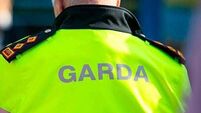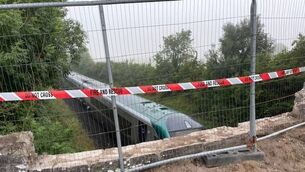Shackleton’s cabin finds a home in Athy

A bird's-eye view of the cabin on a platform at the back of the Shackleton Museum in Athy. Photos: Aisling Hyland
THERE was a distinct sense of history in the air at Kilkea House on Thursday morning, 4th July.
A small group of people patiently awaited the arrival of the cabin in which the famous Antarctic explorer Ernest Shackleton died, onboard the in January 1922, aged just 47. His story had come full circle – Shackleton was born at Kilkea House in 1874 and now, on the road outside, was the place he'd spent his final moments.
“It’s an historic moment,” said Richard Greene, who lives in Kilkea House and took the opportunity to physically touch and take in the storied artefact. “It’s 150 years since he was born here.” Kilkea was the cabin's final stop before arriving in Athy, where it will be the focal point of the Shackleton Museum which is currently being redeveloped. Visitors will have the chance to walk around and reflect upon the cabin and its significance in what will be the world’s premier museum celebrating the life story of Shackleton, Irish polar exploration and the wider heritage of Athy.
For the last number of years, the cabin has been in Letterfrack in Connemara. It has been the subject of careful restoration and conservation under the guidance of conservator Sven Habermann. Shackleton enthusiasts and some curious onlookers watched as the artifact was carefully craned onto a platform and then rolled into the museum which is due to reopen next year. Afterwards, Sven explained that it was something of a weight off his shoulders!

“Having such a significant object in my care requires a lot of attention and a lot of care to make sure that no coincidental accidents happen or anything could happen to this object, because it is really unique and irreplaceable,” he said. “So, having it handed over now to the museum is great.” Among those watching on was Kevin Kenny, another Shackleton stalwart who is one of the organisers of the annual Shackleton Autumn School in Athy.
“This is going to be the central part of the display of the Shackleton story, because really this is where his life ended, in that cabin,” he said. “It's also the most substantial piece of any of Shackleton's ships that still exists... it's a very important piece to anyone who wants to know about the Shackleton story.” Shackleton died aboard in 1922 off the island of South Georgia in the South Atlantic, on his fourth journey to the Antarctic. Just seven years before, he had captured the attention of the world when he enabled the survival of all 27 members of his crew after their ship, the , was trapped and sunk by sea ice during the Imperial Trans-Antarctic Expedition. Following Shackleton’s death, was sold to a Norwegian shipping company and the cabin was removed. It was used as a garden shed by a Norwegian family who owned it for many years.
The cabin was donated to the Shackleton Museum and the committee went about looking for the best person to head up the conservation of this priceless artifact. They went knocking on Sven’s door.
“In 2015 we collected it in northern Norway, and since then it has been in storage with us in Letterfrack, and of course, we did some work on it as well while it was with us,” Sven said. “But of course we didn't work on it for nine years.”
Its arrival in Athy came just weeks after news that the wreck of had been located. The Shackleton Quest Expedition, led by the Royal Canadian Geographical Society (RCGS), discovered the historic wreck lying at a depth of 390m off the coast of Newfoundland and Labrador.
The discovery was the result of painstaking work. They researched historic logs and maps, and cross-referenced the historical data with modern technology to determine where the ship may have been located based on currents, weather conditions and other factors.
The expedition team included Jan Chojecki, grandson of John Quiller Rowett, the man who financed Shackleton’s final journey to the Antarctic. Also on board was Norwegian Tore Topp whose family owned from 1923 to 1962.
“Finding is one of the final chapters in the extraordinary story of Sir Ernest Shackleton,” said expedition leader John Geiger, CEO of the RCGS. “Shackleton was known for his courage and brilliance as a leader in crisis. The tragic irony is that his was the only death to take place on any of the ships under his direct command.”






